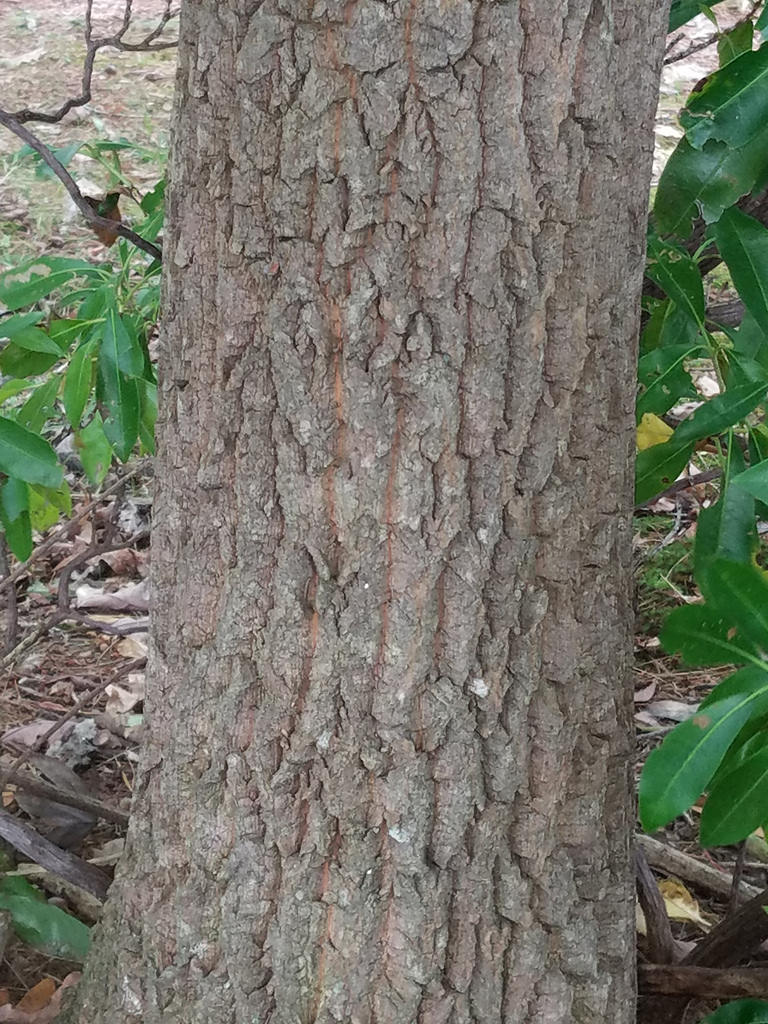Sourwood
Oxydendrum arboreum (L.) DC
Description
Oxydendron arboreum is commonly referred to as sourwood, lily-of-the-valley tree, or sorrel tree³. It is a small, deciduous tree that ranges 30-70 feet³, and has a diameter of up to 20 inches². The bark is thick, and appears to be broken into rectangular ridges¹ that appear a grayish-brown with deep cracks 6. When grown in an open forest, sourwood typically has a pyramidal branch structure with branches facing towards the ground. In forest growth, sourwood has a conical or rounded shape that reach outward ³. It produces shiny green leaves that become a vibrant red, pink and purple in the fall. Its leaves are typically 4-8 inches and have an entire to finely serrate margins5,6. The small, white, fragrant flowers are bell shaped and produced in early summer³. The inflorescence resembles lily of the valley³. The fruit ripens in he fall through the winter 6.

Leaves of sourwood. K Morse 12

Aspect and fall foliage of sourwood. B. Rembert 12

Bark of sourwood. 9

Flowers of sourwood. K. Morse 12

Inflorescence of sourwood. K. Morse 12
Distribution
Sourwood is native to the Eastern United States from southeastern Louisiana to southern Ohio and is mainly found between 30° and 40° North latitude and 75° to 92° West longitude7. Sourwood occurs in well drained soils that are typically acidic, loamy and sandy favoring those composed of clay². Sourwood does not grow well in dry or in flooded soils9. It grows from shade to full sun as it is typically found growing under the canopy of taller trees8. In Maryland sourwood can occasionally be found in Garrett, and Worcester counties9.

Natural distribution of sourwood 13
Wildlife Importance
Sourwood is known to be used by white-tailed deer providing sprouts as a food source10. Sourwood trees are also utilized by birds for nesting. Other small mammals utilize them as a habitat and food source. The flowers provide nectar for honey bees.
Economic Importance
Sourwood’s main attribute from an economic standpoint comes from their striking appearance. It provides an attractive tree desired for landscaping and ornamental uses based on their brightly colored fall leaves and attractive flowers which are relatively unique in the surrounding area³. Bees from sourwood produce an extremely delicious honey².
Threats
Insects such as the dogwood twig-borer, and the twig borer prey upon the sourwoods twigs. The leaves of sourwoods are often preyed upon by the fall webworm and the hickory horned devil10. Sourwood is killed by even low-intensity fires10. There are no diseases that affect sourwood7.
Interesting Facts
- Sourwood is the only member of the heath family (Ericaceae) in Maryland that is a tree9, and Oxydendrum arboreum is the only member of the genus10.
- The common name of sourwood comes from the sour taste of its leaves².
- Native Americans historically used the edible leaves of sourwood trees to cure maladies and stomach discomfort11.
Reference
- Virginia Tech Dendrology: Sourwood
- Arbor Day Foundation: Sourwood
- Ladybird Johnson Wildlife Center: Oxydendrum arboreum
- Bernheim Arboretum and Research Forest: Sourwood
- University of Florida–IFAS Extension: Oxydendrum arboreum
- Missouri Botanical Garden: Oxydendrum arboreum
- USDA Forest Service Silvics, Vol2–Hardwoods: Oxydendrum arboreum
- The Spruce: How to grow and care for sourwood
- Maryland Biodiversity Project: Sourwood
- USDA Forest Service–Fire Effects Information System: Oxydendrum arboreum
- Blue Ridge Country–November’s Wild and Edible: Sourwood
- CalPhoto: Oxydendrum arboreum
- Wikipedia: Oxydendrum
Contributed by S. Sudnick
